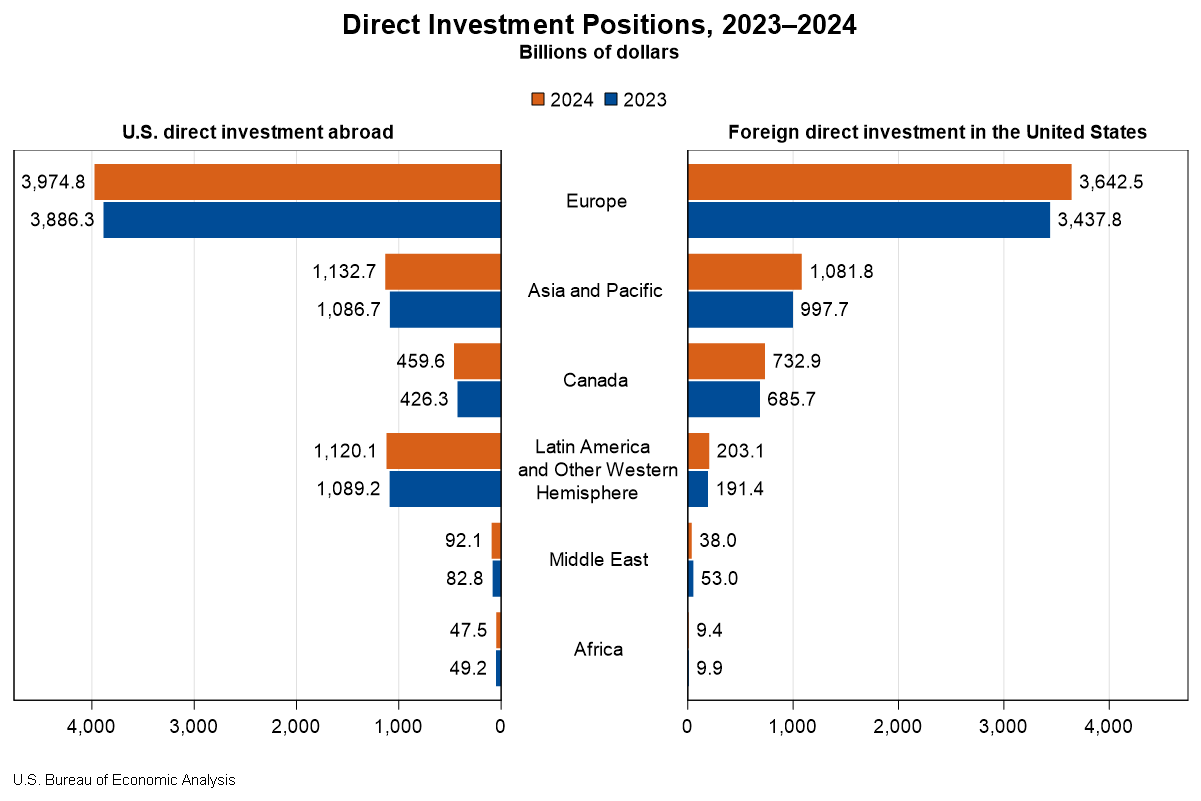Bureau of Economic Analysis
Direct Investment by Country and Industry, 2024
The U.S. direct investment abroad position, or cumulative level of investment, increased $206.3 billion to $6.83 trillion at the end of 2024, according to statistics released today by the U.S. Bureau of Economic Analysis. The increase was led by an $88.4 billion increase in the position in Europe, primarily in Luxembourg and Germany. By industry, manufacturing affiliates had the largest increase, led by manufacturing of computers and electronic products.
The foreign direct investment in the United States position increased $332.1 billion to $5.71 trillion at the end of 2024. The increase was led by a $204.7 billion increase in the position from Europe, which reflected a $52.9 billion increase from the United Kingdom and a $39.7 billion increase from Germany. By industry, affiliates in manufacturing increased the most.
Principal Federal Economic Indicators
Noteworthy
- 2025 News Release Schedule
- Innovation at BEA
- 2025 Annual Updates
- New! Services Trade Data for More Countries
- Data Tool: Trade in Value Added
- Distribution of State Personal Income
- Updated: RIMS II Regional Multipliers
- Arts and Culture
- Space Economy
- FDI Now in State BEARFACTS
- Quick Guide: Price Indexes
The Latest
U.S. Current-Account Deficit Increases in 2012
The U.S. current-account deficit—the combined balances on trade in goods and services, income, and net unilateral current transfers—increased to $475.0 billion (preliminary) in 2012 from $465.9 billion in 2011. As a percentage of U.S. gross domestic product, the deficit decreased to 3.0 percent in 2012 from 3.1 percent in 2011.
U.S. Current-Account Deficit Decreases in Fourth Quarter 2012
The U.S. current-account deficit—the combined balances on trade in goods and services, income, and net unilateral current transfers—decreased to $110.4 billion (preliminary) in the fourth quarter of 2012 from $112.4 billion (revised) in the third quarter of 2012. As a percentage of U.S. gross domestic product, the deficit remained at 2.8 percent. The previously published current-account deficit for the third quarter was $107.5 billion.
U.S. International Transactions, 4th quarter and Year 2012
Sarah Scott: (202) 606-9286 Paul W. Farello: (202) 606-9561 (Revisions) The U.S. current-account deficitthe combined balances on trade in goods and services, income, and net unilateral current transfersdecreased to $110.4 billion (preliminary) in the fourth quarter from $112.4 billion (revised) in the third quarter. The decrease in the current- account deficit was accounted for by increases in…
January 2013 Trade Gap is $44.4 Billion
The U.S. monthly international trade deficit increased in January 2013, according to the U.S. Bureau of Economic Analysis and the U.S. Census Bureau. The deficit increased from $38.1 billion (revised) in December to $44.4 billion in January, as imports increased and exports decreased. The previously published December deficit was $38.5 billion. The goods deficit increased $5.7 billion from December to $61.8 billion in January, and the…
Real Disposable Personal Income Falls in January
Personal income decreased 3.6 percent in January after increasing 2.6 percent in December, reflecting accelerated bonus payments and dividend distributions in December in anticipation of income tax rate changes.
Personal Income and Outlays, January 2013
Personal income decreased $505.5 billion, or 3.6 percent, and disposable personal income (DPI) decreased $491.4 billion, or 4.0 percent, in January, according to the Bureau of Economic Analysis. Personal consumption expenditures (PCE) increased $18.2 billion, or 0.2 percent. In December, personal income increased $353.4 billion, or 2.6 percent, DPI increased $325.7 billion, or 2.7 percent, and PCE increased $14.8 billion, or 0.1 percent, based…
GDP Growth Slows in Fourth Quarter
Real gross domestic product (GDP) increased 0.1 percent in the fourth quarter of 2012 after increasing 3.1 percent in the third quarter, according to estimates released by the Bureau of Economic Analysis. The fourth-quarter growth rate was revised up 0.2 percentage point from the advance estimate released in January. Real GDP increased 2.2 percent in 2012 after increasing 1.8 percent in 2011.
Fourth-quarter highlights The following…
Gross Domestic Product, 4th quarter and annual 2012 (second estimate)
Real gross domestic product -- the output of goods and services produced by labor and property located in the United States -- increased at an annual rate of 0.1 percent in the fourth quarter of 2012 (that is, from the third quarter to the fourth quarter), according to the "second" estimate released by the Bureau of Economic Analysis. In the third quarter, real GDP increased 3.1 percent. The GDP estimate released today is based…
Growth Continues Across the Nation's Metropolitan Areas
Metropolitan areas accounted for nearly 90 percent of national current-dollar gross domestic product (GDP). The ten largest metropolitan areas accounted for 38 percent of national GDP in 2011, while the smallest 79 metropolitan areas accounted for 2 percent of national GDP.




